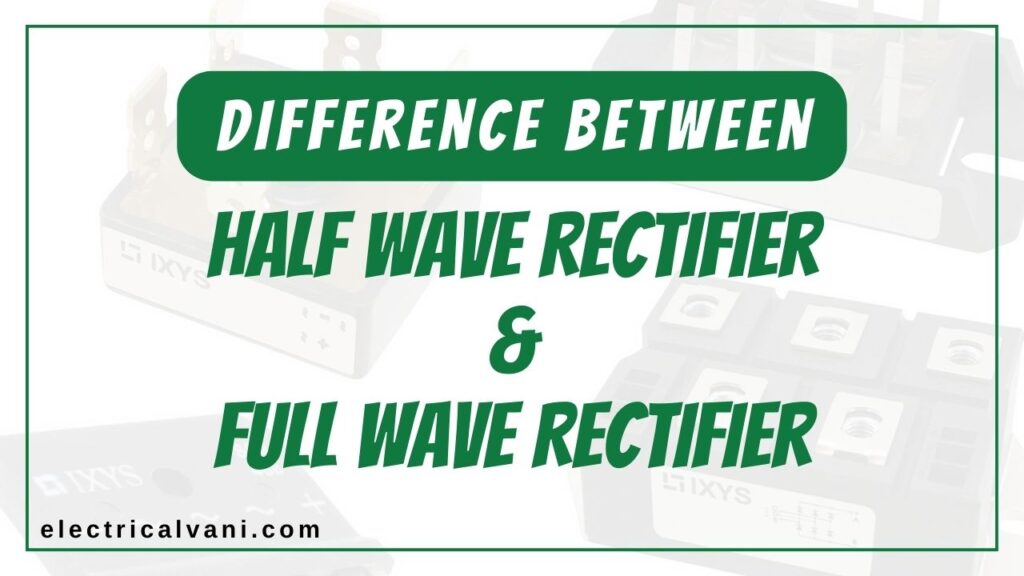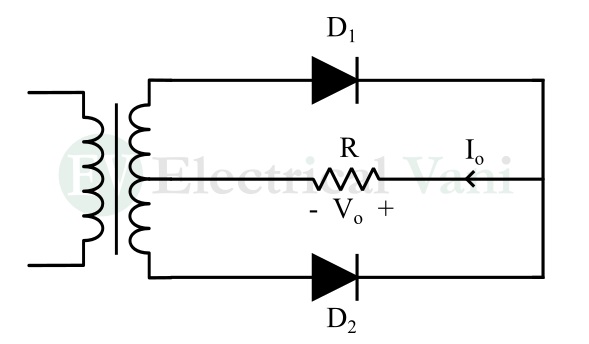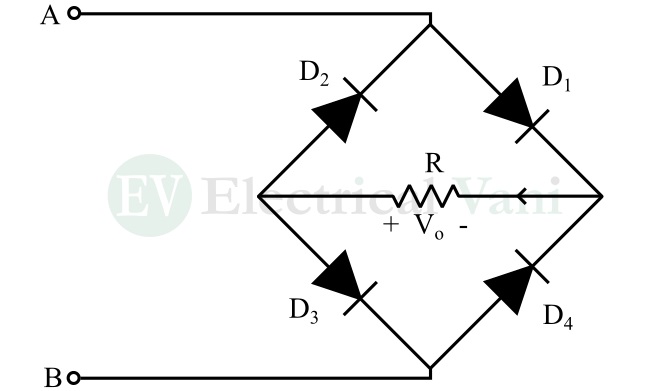In this article, I will explain the important difference between half wave and full wave rectifier. In electronics, a rectifier is an electronic circuit used for converting alternating current (AC) into direct current (DC). The rectifiers are broadly classified into two main types namely, half-wave rectifiers and full-wave rectifiers.

The primary difference between half wave and full wave rectifier is that a half-wave rectifier converts only half cycle of the alternating current into direct current, whereas a full-wave rectifier can convert a complete cycle i.e., positive half and negative half cycle, of alternating current into direct current.
What is a Half-Wave Rectifier?
A half-wave rectifier is an electronic circuit consisting of diodes and a transformer to convert alternating current into direct current. It is called a half-wave rectifier because it can convert only half cycle, either positive half cycle or negative half cycle, of the alternating current into direct current.
The electronic circuit of a typical half-wave rectifier is shown in the following figure.

It consists of a p-n junction diode connected between the input and output. This diode is the main component that performs the AC to DC conversion.
The input alternating current is first stepped down or stepped up as per the need before supply it to the rectifier. For this purpose, a suitable transformer is employed.
Working of Half-Wave Rectifier
The working of the half-wave rectifier circuit shown in the above figure is explained below:
- Positive Half Cycle of AC – In this period, terminal A is positive with respect to terminal B. This makes the diode D forward biased. Thus, the diode acts like a closed switch and current will flow in the circuit and a voltage Vo is available at the output terminals.
- Negative Half Cycle of AC – During the negative half cycle of alternating current, terminal A is negative with respect to terminal B. This makes the diode D reverse-biased and it acts as an open switch. Hence, no current will flow in the circuit and no voltage is available at the output terminals.
This way, the above circuit of the half-wave rectifier converts the half cycle of alternating current into direct current.
What is a Full Wave Rectifier?
A type of rectifier that can convert a complete cycle i.e., both positive and negative cycles, of the alternating current into direct current is called a full-wave rectifier.
Based on the circuit construction, full wave rectifiers can also be classified into the following two types:
- Center-tap full wave rectifier
- Bridge-type full wave rectifier
Working of Full Wave Rectifier
In the center-tap full wave rectifier, a center-tap transformer and two diodes are used. The circuit diagram of the center-tap full wave rectifier is shown in the following figure.

In this circuit, the diode D1 converts the positive half cycle of input AC into DC, while the diode D2 converts the negative half cycle of AC into DC. Thus, this rectifier circuit converts a complete cycle of AC into DC.
In a bridge-type full wave rectifier, four diodes are connected in the form of a bridge as shown in the following figure.

In the bridge full wave rectifier, the diodes D1 and D3 convert the positive half cycle of AC into DC and the diodes D2 and D4 convert the negative half cycle of AC into DC.
Applications of Rectifiers
Half-wave and full-wave rectifiers are widely used in the following applications:
- Battery chargers
- Electronic devices
- Charging adapters
- Inverters
- Voltage multipliers
- Motor drivers, etc.
Till this section of the article, we have studied about fundamentals of half-wave and full-wave rectifiers. Let us now understand the major differences between half-wave and full-wave rectifiers.
Difference between Half Wave and Full Wave Rectifier
The important differences between half-wave and full-wave rectifiers are given in the following table:
| Parameter |
Half-Wave Rectifier |
Full-Wave Rectifier |
| Function | The half-wave rectifier converts only half a cycle of alternating current into direct current. | The full-wave rectifier converts the complete cycle of alternating current into direct current. |
| Number of diodes | Half wave rectifier uses only one diode. | Full-wave rectifiers consist of either two or four diodes. |
| Types | There is no further classification of half-wave rectifier. | Full-wave rectifiers are of two types namely, center-tap full-wave rectifiers and bridge-type full-wave rectifiers. |
| Necessity of transformer | There is no necessity for a transformer. | The center-tap rectifier must require a center-tap transformer, but the bridge rectifier does not require it. |
| Output frequency | In a half-wave rectifier, the output frequency is equal to the input frequency i.e., fo = fi. | In a full wave rectifier, the output frequency is equal to twice of the input frequency i.e., fo = 2fi. |
| Output current | Half-wave rectifier produces a discontinuous output current. | Full-wave rectifier provides a continuous output current. |
| Maximum efficiency | The maximum rectification efficiency of a half-wave rectifier is 40.6%. | The maximum rectification efficiency of a full-wave rectifier is 81.2%. |
| Ripple factor | In the case of the half-wave rectifier, the ripple factor is 1.21. | In the case of the full-wave rectifier, the ripple factor is 0.482 which is lower than that of the half-wave rectifier. |
| Average output DC voltage | Half wave rectifier provides a lower average output DC voltage. | Full wave rectifier provides a higher average output DC voltage comparatively. |
| Peak inverse voltage | Half wave rectifier has a lower PIV rating. It is equal to Vm. | For the center-tap full wave rectifier, the PIV rating is 2Vm and for the bridge-type rectifier, the PIV rating is Vm. |
| Voltage regulation | Half wave rectifier has poor voltage regulation. | The full-wave rectifier has better voltage regulation than the half-wave rectifier. |
| Transformer utilization factor | The half-wave rectifier has a lower transformer utilization factor. | Full wave rectifier has a higher transformer utilization factor. |
| Circuit complexity | The half-wave rectifier circuit is simple. | The full wave rectifier circuit is relatively complex. |
| Cost | The half-wave rectifier uses fewer components; hence the cost is lower. | Due to more number of electronic components, full-wave rectifiers are costly. |
| Average current output | For a half-wave rectifier, the average current output is equal to 0.318 times Im. | For a full wave rectifier, the average current output is equal to 0.637 times of Im. |
| Applications | Half-wave rectifiers are mainly used in low-power applications. | Full-wave rectifiers are used in high-power applications. |
Conclusion
In conclusion, a half-wave rectifier is an electronic circuit that converts a half-cycle of AC into DC, while a full-wave rectifier is an electronic circuit that converts a complete cycle of AC into DC. In this detailed article on the “difference between half-wave and full-wave rectifiers”, we have discussed all the important differences between half-wave and full-wave rectifiers along with their basic theory and working.